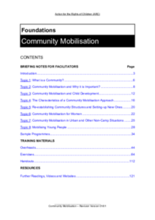UNHCR is mandated by the United Nations to lead and co-ordinate international action for the world-wide protection of refugees and the resolution of refugee problems. In seeking to devise lasting solutions to refugees’ plight, it has been generally agreed that the approach of community mobilisation should be integrated into all phases of emergency relief. The consultation and participation of the communities in the planning and operation of projects will reflect the needs and concerns of the community, will draw on and make good use of the resources of the community, and will enhance the sense of ownership. Moreover, this practice conveys the image of communities as active, resourceful and survivors in the face of adversity. This in turn contributes to the (re)building of their self-esteem and self-respect, and prevents the long-term development of a dependency relationship with external agencies.
This Resource Pack explores the definition of community and community mobilisation and discusses the importance, benefits and challenges to this approach for refugees and other displaced persons, in general, and children, in particular.
Specific topics covered include:
-
Context-specific community mobilisation
-
The importance of community mobilisation
-
How community structures contribute to strengthening children’s development
-
The characteristics of a community mobilisation approach
-
Factors that aid decision-making around the re-establishment of community structures
-
The value of community mobilisation for women
-
The challenges of community mobilisation in urban and non-camp settings
-
Strategies for mobilisation of young people
©Action for the Rights of Children

